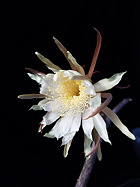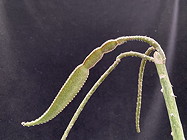This species was previously distributed as ISI 2019-1. However, the new nomenclature is still sinking in, so we found ourselves reverting to our tuberous roots and calling it by its synonym, Peniocereus rosei. As stated in 2019, the name used for this current offering is justified by the DNA work of Salvador Arias et al. (Journal of Plant Research 118:317-328, 2005), while the formal recombination was published by Joel Lodé. Whatever you call it, it is a fascinating geophytic cactus with dimorphic stems emerging from subterranean tubers. Mature stems are pencil thin and cylindrical, while juvenile 3- to 4-angled stems are easily broken at the joints and act as propagules, often taking root where they land. Both stem types exhibit the cryptic, camo-colored mottling of dark green, brown, and pinkish that makes them a challenge to spot in the underbrush in which they grow. The distribution of another well-documented collection will increase the diversity of the ex-situ gene pool as well as recognize the efforts of past researchers Myron Kimnach and Hernando Sanchez-Mejorada. HBG 39316 is their collection, MK 2269, made November 14, 1977: Mexico; Sinaloa; at the base of Sierra de Pinal, just E of El Espinal, on nearly level ground. We offer rooted cuttings for $10.

Published in the Cactus and Succulent Journal, Vol. 94 (2), Summer 2022


